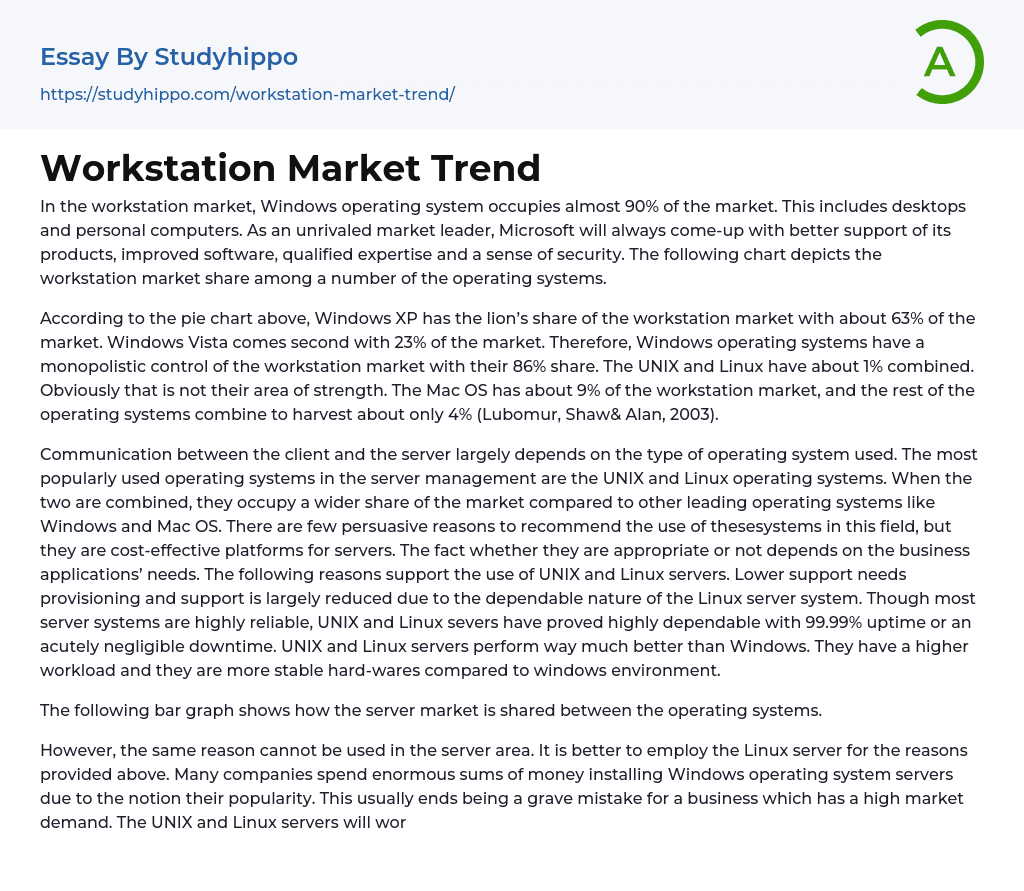In the workstation market, Microsoft's Windows operating system has a dominant market share of almost 90%, covering desktops and personal computers. With unparalleled leadership in the market, Microsoft consistently offers excellent support for its products, improved software, expert knowledge, and robust security. The following chart demonstrates the market share of different operating systems in the workstation market.
According to the provided pie chart, Windows XP dominates the workstation market with a 63% market share. Windows Vista holds second place with a 23% market share. This means that Windows operating systems collectively monopolize 86% of the workstation market. In contrast, UNIX and Linux only have a combined market share of approximately 1%, indicating that this is not their strong suit. Mac OS occupies about 9% of the workstation market, while other operating systems make up just 4%. The
...choice of operating system significantly impacts communication between client and server.
UNIX and Linux are widely used in server management and together have a larger market share compared to Windows and Mac OS. Despite having only a few compelling reasons for recommending their use in this field, UNIX and Linux platforms remain cost-effective options for servers. The suitability of these systems depends on the specific needs of business applications.
There are several reasons supporting the use of UNIX and Linux servers. One reason is that they require lower support provisioning due to their reliable nature, resulting in reduced need for extensive support. While most server systems are highly reliable, UNIX and Linux servers have shown exceptional dependability with an uptime rate of 99.99% or virtually no downtime (Lubomur, Shaw & Alan, 2003).In terms of performance, UNIX and Linux servers surpass Windows
Linux servers are renowned for their superior workload capacity and stability compared to Windows. A bar graph illustrating server market share indicates a preference for Linux over Windows in this domain. Despite the popularity of Windows operating system servers, it is a costly mistake for many companies to assume that popularity equates to quality. Therefore, the use of Linux servers is recommended. Factors to consider when migrating include hardware cost and quality, as well as software licensing costs. UNIX and Linux provide free software, which offers advantages in terms of support costs and ease of use. Other crucial considerations encompass reliability, performance, security, and productivity levels. Ultimately, the choice of operating system for a business should be guided by the total cost of ownership (Hank, 1998; Brian 2000). However, it is not feasible to apply the same reasoning in the server realm. Opting for a Linux server is preferable due to the aforementioned reasons. Overall, operating systems play a vital role in business operations and success. Finding one single operating system that fully meets all business needs is nearly impossible. Henceforth, it is advisable to combine operating systems in order to completely fulfill business requirements.
Windows dominates the workstation market because it boasts compatibility with most softwareWhen combined with Mac OS X, the software is more suitable for that aspect of the business. Additionally, it can offer faster performance and improved time management.
- Computer File essays
- Desktop Computer essays
- Servers essays
- Camera essays
- Cell Phones essays
- Computer essays
- Ipod essays
- Smartphone essays
- Android essays
- Application Software essays
- Benchmark essays
- Computer Network essays
- Computer Programming essays
- Computer Security essays
- Computer Software essays
- Cryptography essays
- Data collection essays
- Data Mining essays
- Graphic Design essays
- Information Systems essays
- Internet essays
- Network Security essays
- Website essays
- World Wide Web essays
- Microsoft Windows essays
- Collective Bargaining essays
- Corporate Culture essays
- Hard Work essays
- Job Satisfaction essays
- Organizational Culture essays
- Organizational Structure essays
- Sweatshops essays
- Workforce essays
- Working capital essays
- Working Class essays
- Working Time essays
- Workstation essays




